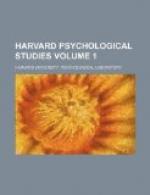Some careful work has been done in the general field of psychical inhibition. In fact, the question of inhibition could hardly be avoided in any inquiry concerning attention or volition. A. Binet[2] reports certain experiments in regard to the rivalry of conscious states. But the states considered were more properly those of attention and volition than of mere ideation. And the same author reports later[3] examples of antagonism between images and sensations, showing how the latter may be affected, and in some respects inhibited, by the former. But this is inhibition of sensations rather than of ideas. Again, Binet, in collaboration with Victor Henri,[4] reports certain inhibitory effects produced in the phenomena of speech. But here again the material studied was volitional. More recently, G. Heymans[5] has made elaborate investigation of a certain phase of ‘psychische Hemmung,’ and showed how the threshold of perception may be raised, for the various special senses, by the interaction of rival sensations, justly contending that this shifting of the threshold measures the degree in which the original sensation is inhibited by its rival. But the field of inquiry was in that case strictly sensational. We find also a discussion by Robert Saxinger,[6] ‘Ueber den Einfluss der Gefuehle auf die Vorstellungsbewegung.’ But the treatment there, aside from the fact that it deals with the emotions, is theoretical rather than experimental.
[2] Binet, A.: Revue Philosophique, 1890, XXIX., p. 138.
[3] Binet, A.: Revue Philosophique, 1890, XXX., p. 136.
[4] Binet, A., et Henri, V.:
Revue Philosophique, 1894,
XXXVII., p. 608.
[5] Heymans, G.: Zeitschrift
f. Psych. u. Physiol. d.
Sinnesorgane, 1899, Bd.
XXI., S. 321; Ibid., 1901, Bd.
XXVI., S. 305.
[6] Saxinger, R.: Zeitschrift
f. Psych. u. Physiol. d.
Sinnesorgane, 1901, Bd.
XXVI., S. 18.
In short, it appears that though much has been said and done upon the general subject of psychical inhibition, experimental inquiry into the inhibitory effect of one idea upon another—abstraction made, as far as possible, of all volitional influence—virtually introduces us to a new phase of the subject.
The term ‘idea,’ it should be noted, is here used in its broadest sense, and includes the memory image. In fact, the memory image and its behavior in relation to another memory image formed the material of the first part of the research, which alone is reported here. Apparatus and method were both very simple.
The ideas to be compared were suggested by geometrical figures cut out of pasteboard and hung, 25 cm. apart, upon a small black stand placed on a table in front of the observer, who sat at a distance of four feet from the stand. The diagrams and descriptions which follow will show the character of these figures.




